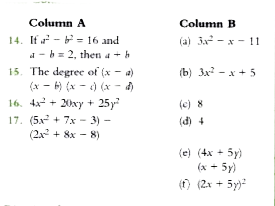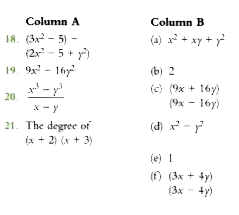Complete Solutions to Concept Application (Level 1) of chapter EXPRESSIONS AND SPECIAL PRODUCTS of Class 7 book with complete answers and questions
| Class 7 | MATHS |
| Chapter | EXPRESSIONS AND SPECIAL PRODUCTS |
| PEARSON IIT JEE FOUNDATION | Concept Application (Level 1) |
| Number Of Questions | 30 |
| Academic Year | 2023-24 |
Which of the following pairs is/are like terms ?
(A) x `" " (B) x^(2)`
(C) `3x^(3) " " (D) 4x^(3)`
View SolutionDegree of `5x^(2)y + 3xy` is `"_______"`.
View SolutionZero of `3x - (3)/(2)` is `"________"`
View SolutionIf x , y , and z are variables , then x + y + z is a `"________"`.
View SolutionWhich of the following is not an identify ?
View SolutionThe zero of 2x + 3 is `"______"`.
View SolutionThe expanded form of `(x+ y)^(2)` is a `"_______"`.
View Solution`sqrt((256a^(4)b^(4))/(625a^(2)b^(2))) = "_______"`
View Solution`(a^(2) - b^(2))/(a-b) = "_______"`
View SolutionThe following steps are involved in expanding `(x+ 3y)^(2)` . Arrange them in sequential order from the first to the last .
(A) `(x + 3y)^(2) = x^(2) + 6xy + 9y^(2)`
(B) `(x + 3y)^(2) = (x)^(2) + 2(x)(3y) + (3y)^(2)`
(C) Using the identify `(a + b)^(2) = a^(2) + 2ab + b^(2)` , where a = x and b = 3y.
View SolutionThe following steps are involved in finding the value of `(97)^(2)` by using a suitable identify . Arrange them in sequential order from the first to the last .
(A) 10000 - 600 + 9 = 9409
(B) Using the identify `(a - b)^(2) = a^(2) - 2ab + b^(2)`, where a = 100 and b = 3.
(C) `(97)^(2) = (100 - 3)^(2)`
(D) `(100-3)^(2) = (100)^(2) - 2 (100)(3) + 3^(2)`
View SolutionThe following steps are involved in finding the value of `a^(4) + (1)/(a^(4))` when `a + (1)/(a) = 1` . Arrange them in sequential order from the first to the last .
(A) `a^(2) + (1)/(a^(2)) + 2 = 1 implies a^(2) + (1)/(a^(2)) = -1`
(B) `(a^(2))^(2) + ((1)/(a^(2))^(2))^(2) = 1^(2)`
(C) `(a + (1)/(a))^(2) = 1^(2)`
(D) `(a^(2) + (1)/(a^(2)))^(2) = (-1)^(2)`
E `a^(4) + (1)/(a^(4)) = -1`
View SolutionThe following steps are involved in the factorisation of `x^(2) (x - y) + (y-x) y^(2)`. Arrange them in sequential order from the first to the last .
(A) `(x-y) [x^(2) - y^(2)]`
(B) `x^(2)(x-y) - ( x- y) y^(2)`
(C) `(x-y)^(2) (x + y)`
(D) `(x-y) [(x + y)( x-y)]`
View Solution`{:( "Column" A ,, "Column" B) , ("If" a^(2) - b^(2) = 16 "and" a- b = 2 "," "then" a + b,, "(a)" 3x^(2) - x - 11), ("The degree of " (x-a) (x-b) (x - c) (x-d) ,, "(b)" 3x^(2) - x + 5), (4x^(2) + 20xy + 25y^(2) ,, (c) 8), ((5x^(2) + 7x -3)- (2x^(2) + 8x -8) ,, (d) 4), (,, (e) (4x + 5y) (x+ 5y)), (,,(f) (2x + 5y)^(2)):}`
View Solution`{:("Column" A ,, "Column" B), ((3x^(2) - 5)- (2x^(2) - 5 + y^(2)) ,, (a) x^(2) + xy + y^(2)) , (9x^(2) - 16y^(2) ,, (b) 2) , ((x^(3) - y^(3))/(x-y) ,, (c) (9x + 16y) (9x - 16y)) , ("The degree of " (x + 2) (x+3) ,, (d) x^(2) - y^(2)) , (,, (e) 1) , (,, (f) (3x + 4y) (3x - 4y)):}`
View SolutionWhich of the following pairs is/are like terms ?
(A) x `" " (B) x^(2)`
(C) `3x^(3) " " (D) 4x^(3)`
View SolutionDegree of `5x^(2)y + 3xy` is `"_______"`.
View SolutionZero of `3x - (3)/(2)` is `"________"`
View SolutionIf x , y , and z are variables , then x + y + z is a `"________"`.
View SolutionWhich of the following is not an identity ?
View SolutionThe zero of 2x + 3 is `"______"`.
View SolutionThe expanded form of `(x+ y)^(2)` is a `"_______"`.
View Solution`sqrt((256a^(4)b^(4))/(625a^(6)b^(2))) = "_______"`
View Solution`(a^(2)-b^(2))/(a-b)` = _______
View SolutionThe following steps are involved in expanding `(x+ 3y)^(2)` . Arrange them in sequential order from the first to the last .
(A) `(x + 3y)^(2) = x^(2) + 6xy + 9y^(2)`
(B) `(x + 3y)^(2) = (x)^(2) + 2(x)(3y) + (3y)^(2)`
(C) Using the identify `(a + b)^(2) = a^(2) + 2ab + b^(2)` , where a = x and b = 3y.
View SolutionThe following steps are involved in finding the value of `(97)^(2)` by using a suitable identify . Arrange them in sequential order from the first to the last .
(A) 10000 - 600 + 9 = 9409
(B) Using the identify `(a - b)^(2) = a^(2) - 2ab + b^(2)`, where a = 100 and b = 3.
(C) `(97)^(2) = (100 - 3)^(2)`
(D) `(100-3)^(2) = (100)^(2) - 2 (100)(3) + 3^(2)`
View SolutionThe following steps are involved in finding the value of `a^(4) + (1)/(a^(4))` when `a + (1)/(a) = 1` . Arrange them in sequential order from the first to the last .
(A) `a^(2) + (1)/(a^(2)) + 2 = 1 implies a^(2) + (1)/(a^(2)) = -1`
(B) `(a^(2))^(2) + ((1)/(a^(2))^(2))^(2) = 1^(2)`
(C) `(a + (1)/(a))^(2) = 1^(2)`
(D) `(a^(2) + (1)/(a^(2)))^(2) = (-1)^(2)`
E `a^(4) + (1)/(a^(4)) = -1`
View SolutionThe following steps are involved in the factorisation of `x^(2) (x - y) + (y-x) y^(2)`. Arrange them in sequential order from the first to the last .
(A) `(x-y) [x^(2) - y^(2)]`
(B) `x^(2)(x-y) - ( x- y) y^(2)`
(C) `(x-y)^(2) (x + y)`
(D) `(x-y) [(x + y)( x-y)]`
View SolutionMatch Column A with Column B

View SolutionMatch Column A with Column B

View Solution
Concept Application (Level 1) questions and complete solutions for chapter EXPRESSIONS AND SPECIAL PRODUCTS of PEARSON IIT JEE FOUNDATION of Class 7
All Exercises from PEARSON IIT JEE FOUNDATION Class 7 MATHS EXPRESSIONS AND SPECIAL PRODUCTS
- Assessment Tests (Test 1)
- Assessment Tests (Test 2)
- Concept Application (Level 1)
- CONCEPT APPLICATION (LEVEL 2)
- CONCEPT APPLICATION (LEVEL 3)
- Easy Type Questions
- Example
- EXAMPLE 2.1
- Fill in the blanks.
- Find the degree of the following expressions
- Level 2
- Level 3
- Select the correct answer from the given options .
- Short Answer Type Questions
- TEST YOUR CONCEPTS (ESSAY TYPE QUESIONS)
- TEST YOUR CONCEPTS (SHORT ANSWER TYPE QUESTIONS)
- TEST YOUR CONCEPTS (VERY SHORT ANSWER TYPE QUESTIONS)
- Very Short Answer Type Questions